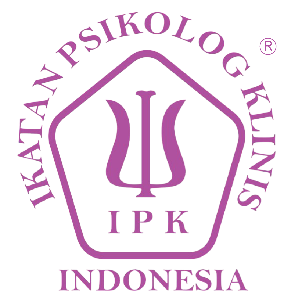Disinhibisi Online sebagai Mediator Hubungan antara Kebingungan Identitas dan Cyberbullying pada Remaja
DOI:
https://doi.org/10.26740/jptt.v11n2.p116-127Keywords:
Cyberbullying, disinhibisi online, kebingungan identitas, remajaAbstract
Cyberbullying behavior utilized the use of digital technology and the internet as a medium for bullying. The purpose of this study was to examine the function of online disinhibition as a mediator of the relationship between identity confusion and cyberbullying in adolescents. Participants in the study were 12 to 15 years old or adolescents, which consisted of 151 men and 196 women. Data collection was performed using 3 scales namely the Cyberbullying Behavior Scale, the identity confusion scale, and the online disinhibition scale. The data obtained were tested using regression analysis with mediator variable with the help of IBM SPSS Statistics 21.0. The results showed that there was an effect of online disinhibition mediation on the relationship of identity confusion with cyberbullying. The result of MacKinnon analysis shows that the direct effect gives a bigger effect than the indirect effect.The results of the additional analysis show that males do more cyberbullying behavior; the higher the duration of internet and social media use, the more cyberbullying behavior that will be carried out by adolescents. These results indicated that adolescents and cyberbullying have many factors that required further research.
Keywords: Cyberbullying, online disinhibition, identity confusion, adolescents
Abstrak: Perilaku cyberbullying memanfaatkan penggunaan teknologi digital dan internet sebagai media untuk melakukan aksi bullying. Tujuan dari penelitian ini adalah untuk menguji fungsi disinhibisi online sebagai mediator hubungan antara kebingungan identitas dan cyberbullying pada remaja. Partisipan dalam penelitian berusia 12 sampai dengan 15 tahun atau remaja yang terdiri dari 151 laki-laki dan 196 perempuan. Pengumpulan data dilakukan menggunakan 3 skala yaitu Skala Perilaku Cyberbullying, Skala kebingungan identitas, dan Skala disinhibisi online. Data yang diperoleh diuji menggunakan analisis regresi dengan melibatkan variabel mediator dengan bantuan IBM SPSS Statistics 21.0. Hasil penelitian menunjukkan bahwa ada pengaruh mediasi disinhibisi online pada hubungan kebingungan identitas dengan cyberbullying. Perhitungan peranan menggunakan MacKinnon diperoleh hasil bahwa efek langsung memberikan peran lebih besar dibandingkan efek tidak langsung. Hasil analisis tambahan menunjukkan bahwa laki-laki lebih banyak melakukan perilaku cyberbullying; semakin tinggi durasi penggunaan internet dan sosial media semakin banyak pula perilaku cyberbullying yang akan dilakukan remaja. Hasil ini menunjukkan bahwa remaja dan cyberbullying memiliki banyak faktor yang memerlukan penelitian lanjutan.
References
Chadwick, S. (2014). Impacts of Cyberbullying, Building Social and Emotional Resilience in School. New York: Springer.
Ching, T., Wu, L. S., & Shih, J.-F. (2017). Examining the Antecendents of Online Disinhibition. Emerald Insight: Information Technology & People, 30(1), 1-26. https://doi.org/10.1108/ITP-07-2015-0167
Dayton, T. (2011). Creating a false self: Learning to live a lie [Web log post]. Retrieved from https://www.huffingtonpost.com/dr-tian-dayton/creating-a-false selflea_b_269096.html
Erikson, E. H. (1968). Identity Youth and Crisis. Ney York: W. W. Norton.
Gayatri, G., Rusadi, U., Meiningsih, S., Mahmudah, D.,Sari, D., Kautsarina, Karman, & Nugroho, A. C. (2015). Perlindungan Pengguna Media Digital di Kalangan Anak dan Remaja di Indonesia. Jurnal Penelitian dan Pengembangan Komunikasi dan Informatika, 6(1), 1-16. Retrieved from http://digilib.mercubuana.ac.id/manager/t!@file_artikel_abstrak/Isi_Artikel_257476942796.pdf
Gil-Or, O., Levi-Belz, Y., & Turel, O. (2015). The "Facebook-self": characteristics and psychological predictors of false self-presentation on Facebook. Frontiers in Psychology, 6(99), 1-10. https://doi.org/10.3389/fpsyg.2015.00099
Görzig, A., & Ólafsson, K. (2014). What Makes a Bully a Cyberbully? Unravelling the Characteristics of Cyberbullies across Twenty-Five European Countries. Journal of Children and Media , 7 (1), 8-25. https://doi.org/10.1080/17482798.2012.739756
Guard Child. (2017). Cyber Bullying Statistics. Retrieved from https://www.guardchild.com/cyber-bullying-statistics/
Herdiana, I. (2018). Media Sosial dan Human Trafficking: Sebuah Ulasan. In H. P. Indonesia, Psikologi dan Teknologi Informasi (pp. 127-144). Jakarta: Himpunan Psikologi Indonesia.
Hidayaah, N., & Farizi, A. M. (2017). Relationship Between Self-Concept and the Intensity of Cyberbullying in Class XI of Dharma Wanita Senior High School Surabaya. Proceeding Surabaya International Health Conference, 1(1), 435-439. http://journal.unusa.ac.id/index.php/sihc/article/view/349/314
Hinduja, S., & Patchin, J. W. (2015). Bullying Beyond Schoolyard: Preventing and Responding to Cyberbullying Second Edition. Thousand Oaks, CA: Sage Publication.
Hu, C., Kumar, S., Huang, J., & Ratnavelu, K. (2017). Disinhibition of negative true self for identity reconstructions in cyberspace: Advancing self-discrepancy theory for virtual setting. Plos One , 12(4), 1-19. https://doi.org/10.1371/journal.pone.0175623
IPSOS. (2011). One in Ten (12%) Parents Online, Around the World Say Their Child Has Been Cyberbullied, 26% Say They Know of a Child Who Has Experienced Same in Their Community. Retrieved from https://www.ipsos.com/en-us/news-polls/one-ten-12-parents-online-around-world-say-their-child-has-been-cyberbullied-26-say-they-know-child
Keipi, T., & Oksanen, A. (2014). Self-exploration, Anonymity and Risks in the Online Setting: Analysis of Narratives by 1418-Year Olds. Journal of Youth, 17(8), 1097-1113. https://doi.org/10.1080/13676261.2014.881988
King, L. (2016). Psikologi Umum: Sebuah Pandangan Apresiatif (Edisi 3 Buku 1). Jakarta: Salemba Humanika.
Li, Q. (2007). New Bottle but Old Wine: a Research of Cyberbullying in Schools. Computers in Human Behavior, 23 (4), 1777-1791. https://doi.org/10.1016/j.chb.2005.10.005
Morissan. (2012). Metode Penelitian Survei. Jakarta: Kencana.
Papalia, D. E., Olds, S. W., & Feldman, R. D. (2009). Human Development Perkembangan Manusia (Edisi 10, Buku 2). Jakarta: Salemba Humanika.
Patchin, J. W., & Hinduja, S. (2010). Cyberbullying and Self-Esteem. Journal of School Health , 80(12), 614-621. https://doi.org/10.1111/j.1746-1561.2010.00548.x
Patchin, J. W., & Hinduja, S. (2012). Cyberbullying Prevention and Response Expert Perspective . New York: Routlege Taylor and Francis.
Ramdhani, N. (2016). Emosi Moral dan Empati pada Pelaku Perundungan-siber. Jurnal Psikologi, 43(1),66-80. https://doi.org/10.22146/jpsi.12955
Rice, E., Petering, R., Rhoades, H., Winetrobe, H., Goldbach, J., Plant, A., et al. (2015). Cyberbullying Perpetration and Victimization Among. American Journal of Public Health , 105 (3), 66-72. https://doi.org/10.2105/AJPH.2014.302393
Schwartz, S. J., Zamboanga, B. L., Weisskirch, R. S., & Rodriguez, L. (2009). The relationships of personal and ethnic identity exploration to indices of adaptive and maladaptive psychosocial functioning. International Journal of Behavioural Development, 33(2), 131-144. https://doi.org/10.1177/0165025408098018
The Jakarta Post. (2016). Most Youth Unaware of Cyberbullying. Retrieved September 3, 2016, from https://www.thejakartapost.com/news/2016/09/03/most-youth-unaware-cyberbullying.html
Udris, R. (2014). Cyberbullying Among High School Student in Japan: Development and Validation of the Online Disinhibition Scale. Computers in Human Behavior , 41, 253-261. https://doi.org/10.1016/j.chb.2014.09.036
Udris, R. (2017). Psychological and Social Factor as Predictors of Online and Offline Deviant Behavior Among Japanese Adolescent. Deviant Behavior, 38(7), 1-18. https://doi.org/10.1080/01639625.2016.1197689
We are Social. (2018, January 30). DigitalL in 2018: World's Internet Users Pass The 4 Billion Mark. Retrieved March 05, 2018, from https://wearesocial.com/blog/2018/01/global-digital-report-2018
Widhiarso, W. (2012). Beberapa Ukuran Efek dalam Analisis Regresi Mediator. Retrieved from https://www.researchgate.net/publication/340137117_Beberapa_Ukuran_Efek_dalam_Analisis_Regresi_dengan_Mediator
Wright, M. F., Harper, B. D., & Wachs, S. (2019). The Association Between Cyberbullying and Callous-unemotional Traits Among Adolescents: The Moderating Effect of Online Disinhibition. Personality and Individual Difference, 140, 41-45.https://doi.org/10.1016/j.paid.2018.04.001
Downloads
Published
How to Cite
Issue
Section
License
Authors who publish in this journal agree to the following terms:
Copyright in any article is held by the author.
The author grants the journal, publication rights with the work simultaneously licensed under a Creative Commons Attribution License that allows others to share the work with an acknowledgment of the work's authorship and initial publication in this journal.
Authors may enter into separate, additional contractual arrangements for the non-exclusive distribution of the journal's published version of the work (e.g., posting it to an institutional repository or publishing it in a book), with an acknowledgment of its initial publication in this journal.
Authors are permitted and encouraged to post their work online (e.g., in an institutional repository or on their website) prior to and during the submission process, as this can lead to productive exchanges, as well as earlier and greater citation of published work.
 Abstract views: 2209
,
Abstract views: 2209
, PDF Downloads: 1238
PDF Downloads: 1238

















